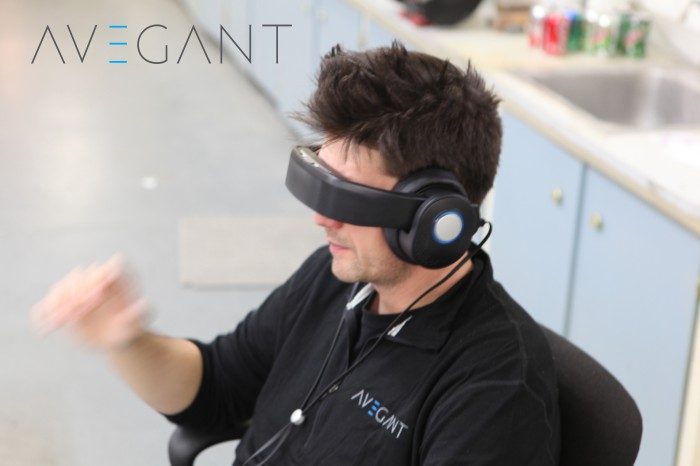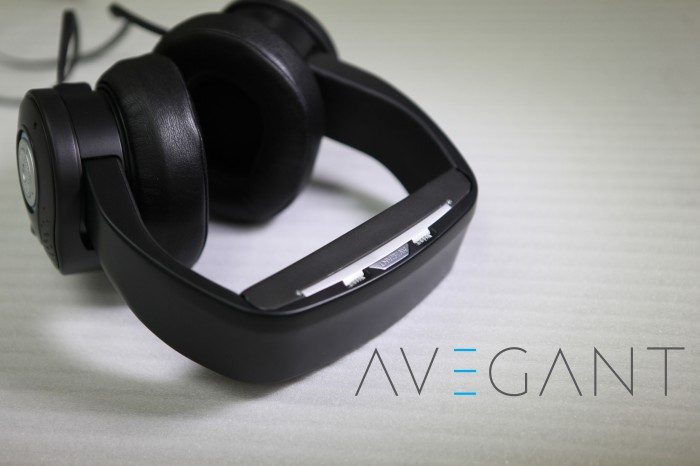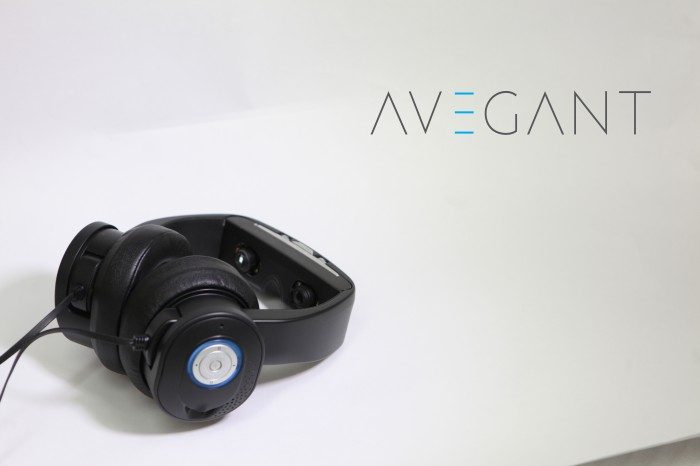Avegant invited Road to VR to have an early look at a prototype of their new transforming virtual retina display based HMD, targeted squarely at the portable entertainment market. Paul James goes hands on with the Avegant Glyph.
Obsessively Designed
“Yes, there will be a cover for the lenses”. This comment from Grant Martin, Avegant‘s Head of Marketing and Product Strategy in response to comments from Road to VR users. The statement belies a certain amount of weariness and frustration. The Avegant team have been working on 3 hours of sleep or less for weeks. They’ve been obsessively honing, measuring and tweaking their prototype in readiness for a near tidal wave of events they’re slated to be involved in over the CES period. The frustration isn’t directed at the commenter, it’s an indication of the obsession the Avegant team have with their new product and that they simply can’t get their ideas integrated into the product quickly enough. It also highlights how keen they are to listen to constructive feedback.
Having already finalised the optics and formulated what they determine an optimal image, they’ve moved onto the product itself. That is, producing something that people want to buy. When I glibly ask what demographic Avegant are targeting with the Glyph, Ed retorts “People who watch movies and listen to music”, I probably deserved that. However, the Glyph certainly isn’t aiming for lowest common denominator when it comes to the AV experience.
What’s It Like?
I sit down to test the unit, looking just like the target renders we featured recently. The unit is designed to shift between Audio/Video and pure Audio mode. It accomplishes this by pivoting the bridge by 90 degrees, bringing the optics, mounted into the underside of the bridge to rest in front of your eyes. The pressure exerted by the bridge keeps the unit in place, with a little help from the user’s nose of course. It’s a neat idea and it looks great, but I had difficulty getting the unit to sit correctly on my ‘challengingly shaped’ head. The unit also allows you to move the bridge as an assembly in and out, in a similar way you’d tighten your headphones. Doing so certainly improves things and I can focus on the image in front of me. The unit produces an image with a 45 degree field of view, the visible portions of which give the impression of a 70-80″ projected image.
The team freely admit they’ve not yet spent enough time addressing ‘Human Factors’. These will be ironed out over the coming weeks as they continue to iterate design changed ahead of the final version.
The unit is designed to be universal, that is to fit as many heads and as many eyes as possible. To this end Avegant have implemented both IPD (Interpupillary Distance) adjustment and individual focus controls for the optics. IPD can be adjusted by two dials, one for each lens. Rotating the dials shift each lens left or right as required. Once you’re comfortable you can lock the adjustment in place by depressing a button between the two dials. It’s another example of attention to detail evident on this still early prototype. After tweaking for a little while, I found an extremely comfortable position.
So, what about that display? Ben Lang tried the development unit Avegant at the recent Engadget: Expand event in New York. To put it mildly he was impressed. As an old AV enthusiast from way back though, I have a tendency to nitpick. In truth, once the video started I found it difficult to criticise what I was seeing.
The first thing to note is the pixel structure – there barely is one. The Glyph benefits from using a brand new type of display VRD (virtual retina display) technology which is essentially an evolution of the now decades old DLP technology (Digital Light Processing), which uses thousands of controlled, spinning mirrors to reflect light into a user’s eyes. Texas Instruments saw what Avegant had in mind and chose them to be the first to integrate their newer, more advanced chips – now with reduced distance between each adjacent mirror. This means the screen door effect you get with other displays when viewed at close range is almost eliminated. Because the separation of pixels are almost eliminated, the perceived resolution is actually much higher and more realistic. The current prototype utilises 2 x 720 displays (one for each eye) but my perception of the image would have put it far beyond. The image sparkles as a result.
One interesting thing to note is that the team have designed the unit with a deliberate ability to reconnect with the real world easily. To explain, your vertical FOV is not entirely occluded, so those who are worried about being disconnected from reality when using the Glyph in public be assured the compromise on show here works quite well.
DLP displays were always hailed for their brightness, that is evident here in spaces. Colours too are incredibly vibrant, natural and, ignoring stereoscopy, have a three dimensional quality to them. It feels as if you’re gazing at an open window in a darkened room as light spills into your eyes in a way that feels extremely natural. My only criticism would be a tendency for bright whites to look a little hot, but in fairness this could be due to the source video.
But this is an HMD of dual functionality. Next to the first rate image, any shortcomings in the audio would of course be amplified, so the team designed and built custom titanium drivers. These drivers are complimented by ear cups with cavities sculpted to produce exactly the kind of found the team were looking for. The team iterated over many designs before they found what they were listening for, something that works well with music of all genres and movies too. Has all that work paid off, yes indeed it has. I listened to various audio tracks and bass felt taught and fast whilst low frequency response still low enough to give depth. Vocals were transparent with no sibilants (despite that titanium) and good stereo imaging was evident. The limited movie time I had showed the headphones capable of an excellent soundstage, but in truth I’d need to sit with full length movies to give my full verdict here. One thing is clear, they sound damn good. Volume is controlled via a neat dial on the right
This is a prattle device of course, so what of battery life. The eventual target is to run for 3 hours on a single charge, that’s in AV mode. Enough for a movie or a decent gaming session for sure, albeit falling some way of the requirements of long distant travellers for sure.
Gaming and What’s Next for Glyph
The Glyph includes an accelerometer based head tracking unit for the purposes of providing possible input to attached mobile devices. It employs Bluetooth 4 to pair with and exchange data. The Glyph isn’t being designed as a gaming headset, but the team felt strongly that giving developers the ability to customise or develop games that work with the HMD was important. It certainly isn’t the team’s primary focus however.
Avegant are gearing up for a Kickstarter campaign due to kick off January 22nd. The Glyph is being pitched at $499 per unit, but neither reward tiers or a target amount for the campaign have yet been decided. On the subject of a future versions of the Glyph with either an increased resolution or an increased FOV, ultimately targeted at Virtual Reality, the team remain open minded.
The Glyph is an intriguing package with a dazzling display and top tier audio capabilities. Avegant are working very hard to ensure that bleeding edge design can work effectively in reality and have their eye on the desirability factor that makes consumer electronics. It’ll be intriguing to see how the Kickstarter fairs with the unit at that price point and beyond how the general public receive such a unique product. We wish Avagent the best of luck with the project.
We’ll also have an interview with the team up for you soon.










